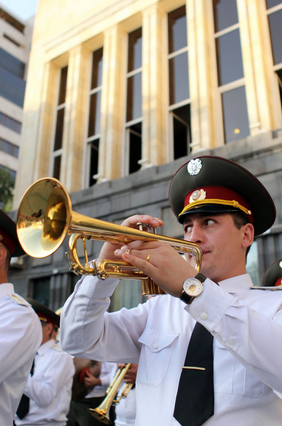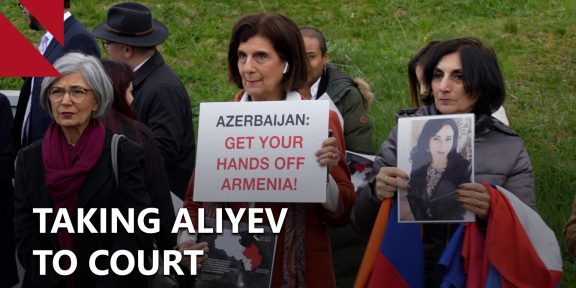 I am a mere spectator. Wandering the streets of Yerevan as a stranger, my role is reduced to observation. Bits and pieces of Armenian fly by, but I am not able to understand. I am distant to the struggles of my neighbors and deaf to the debates in parliament. All that is left to do is react to visual stimuli. Sometimes they make me dream, as does the daily sight of Mount Ararat. And sometimes they make me think, as does the ubiquity of arts and uniforms in Yerevan.
I am a mere spectator. Wandering the streets of Yerevan as a stranger, my role is reduced to observation. Bits and pieces of Armenian fly by, but I am not able to understand. I am distant to the struggles of my neighbors and deaf to the debates in parliament. All that is left to do is react to visual stimuli. Sometimes they make me dream, as does the daily sight of Mount Ararat. And sometimes they make me think, as does the ubiquity of arts and uniforms in Yerevan.
The impression begins every morning in the living room of my apartment. During breakfast, I marvel at a wonderfully dissonant piano. On top of it, old photographs fade away. An unknown man in uniform, machine gun and disarming smile at display for the camera. It continues on my way to work. Passing by the Opera, melodies of stunning beauty float through the open windows. Inevitably, my joy is shared by the occasional guards leaning against the Opera walls. Returning in the evening, a man in a grey uniform helps children cross the street. Two servicemen in green lean their tired heads against the marshrutka window. And the bus driver accelerates in rhythm to his Khachaturian record. Uniforms and Arts are everywhere, wherever one goes or turns.
Yerevan is full of uniforms. They are green and grey, blue and black. There are uniforms on street corners and in supermarkets, across parliament and wherever there is an assembly of people nearby. Yerevan is full of art as well. Statues, most of surprisingly modern shape, bear witness of Armenian heroes on every square. The Golden Apricot International Film Festival draws attention all across the city and my days in Armenia are outnumbered by the house museums of artists throughout the country. Even news coverage draws heavily on the two motifs. Yet, I cannot conceal that I am as irritated by the former, as I am delighted by the latter.
It is tempting to read my impressions dialectically. I was socialized into seeing the good in arts, the bad in uniforms. Following this thought, arts are the past. The heroes of Armenia have museums and statues. Streets are named after them and their Pantheon draws visitors, thirsty of long-gone glory. Uniforms however, are the present, an every-day necessity, to which Armenians have become accustomed. My aversion to one side, Komitas cannot defend Armenia’s borders, but a uniform can. A thought, even more pressing in the last days.
It all depends on my point of reference. I came to Armenia from a country, where Thomas Mann is held in higher regard than Bismarck. 120 Euros per German is spent on the Arts and it is forbidden to enter Parliament in uniform. Soldiers in public are frequently insulted, whereas the Weimar classics are performed to critical acclaim. Following the dialectic motif, the tension between arts and uniforms has been immortalized in Adorno’s polemic that “to write poetry after Auschwitz is barbaric.” But being a spectator in Yerevan forces me to rethink this perspective, because of the simultaneous ubiquity of arts and uniforms.
Benedikt van den Boom
Visiting Journalist from Germany
















